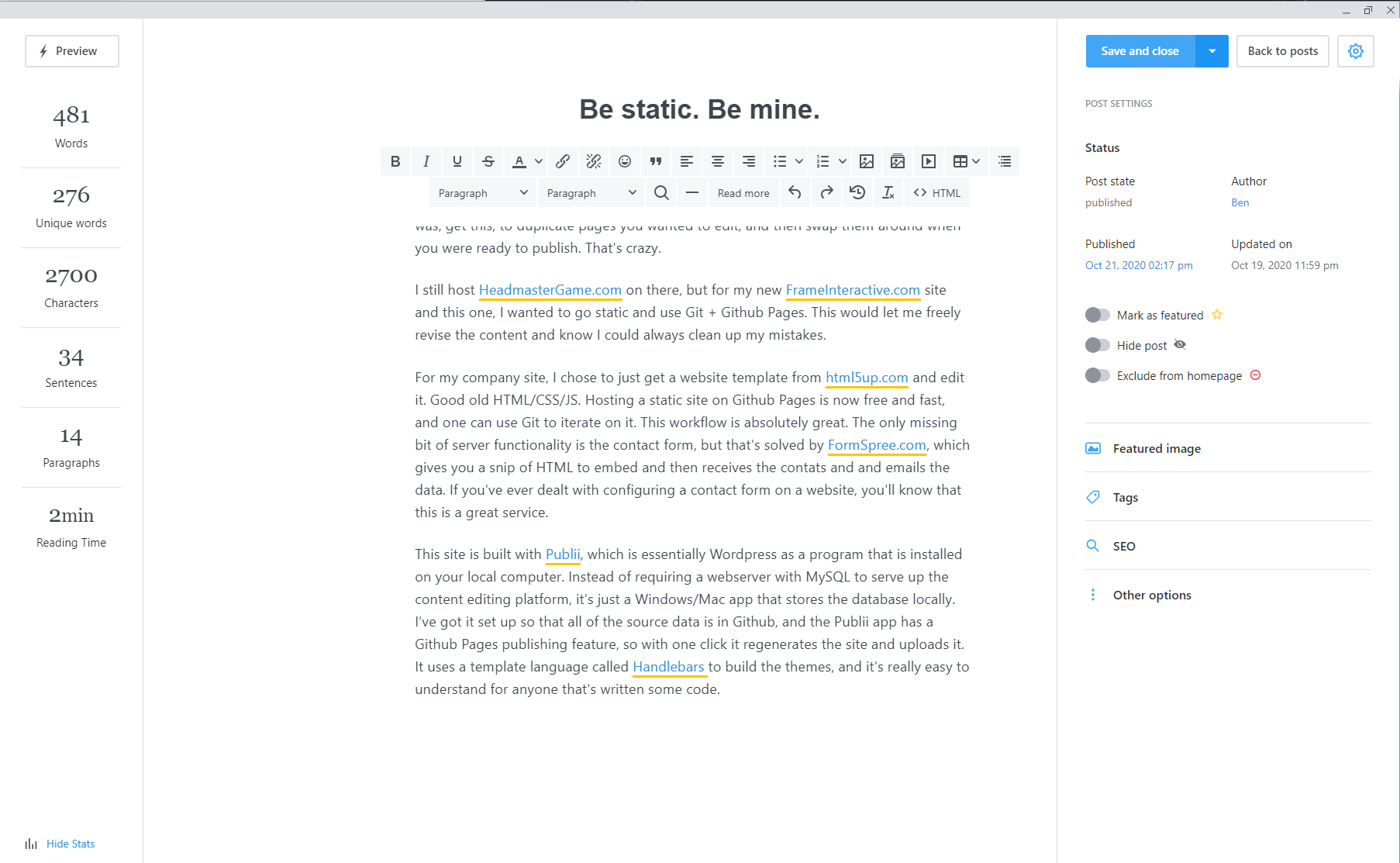Be static. Be mine.
Static Websites Let You Own Your Content.
This post is about why I built this site the way I did, as a "static website" instead of a more traditional way using Wordpress. Most people won't care about this, but I wanted to write it all down anyway!
It's 2020 and besides being the year that everything goes wrong, it's also a good time to reflect on how I communicate online.
Years ago we all had websites. Usually we were apologizing for them. Site building was somewhat difficult until Blogger and Wordpress arrived, and then the blogging revolution took off. For a few years, this was a pretty good scene.
Then social media hit. At first, Facebook and Twitter weren't the only places we existed online, but by the mid 2010's, most people had migrated their entire online presence to these platforms. In the process, we abandoned ownership of our content, and in some respects, ourselves.
There's also a different feeling of persistence with social media. It gives you the sensation of creating something, but then you just toss it into a river and watch it float away.
Somewhere in there, Medium launched. Medium is ostensibly a blogging platform, but in practice, it's just Twitter without a word count. They want to put all content behind a wall and own it.
When I've desired to have websites in the last 5 years, I have done my company and game sites on Squarespace. The platform is really easy to use, can scale to any load, and offers a lot of cool functionality. However I couldn't get over the fact that there was no revision history. You could destroy your entire site with one bad edit. The workaround was, get this, to duplicate pages you wanted to edit, and then swap them around when you were ready to publish. That's crazy.
I still host HeadmasterGame.com on there, but for my new FrameInteractive.com site and this one, I wanted to go static and use Git + Github Pages. This would let me freely revise the content and know I could always clean up my mistakes.
For my company site, I chose to just get a website template from html5up.com and edit it. Good old HTML/CSS/JS. Hosting a static site on Github Pages is now free and fast, and one can use Git to iterate on it. This workflow is absolutely great. The only missing bit of server functionality is the contact form, but that's solved by FormSpree.com, which gives you a snip of HTML to embed and then it takes care of everything. If you've ever dealt with configuring a contact form on a website, you'll know that this is a great service.
Enter Publii
This site is built with Publii, which is essentially Wordpress as a program that is installed on your local computer. Instead of requiring a webserver with MySQL to serve up the content editing platform, it's just a Windows/Mac app that stores the database locally. I've got it set up so that all of the source data is in Github, and the Publii app has a Github Pages publishing feature, so with one click it regenerates the site and uploads it. It uses a template language called Handlebars to build the themes, and it's really easy to understand for anyone that's written some code.

Strategy
With all this in place, I am going to use Twitter as a broadcasting tool like it should be. Twitter should not be the place we write long thoughts, if for no other reason that we lose them. Tweets are not a body of work. I want to create a body of work here.
Comments are an issue, but a comment is often a desire to talk to the post author as opposed to starting a conversation within a community. So I'll make you a deal. If you write me something really interesting via the Contact Form I'll post it back to this page.
:)
Hi, I'm Ben Throop
This is my personal site about game development and emergent behavior. You can learn more about me here.
All Posts
- Elegant GPU Animation in Unity
November 6, 2022 - Compute Shaders and Emergent Algorithms
June 4, 2021 - Brackeys Game Jam 2021.1
March 20, 2021 - MIGS 2017 Talk - Blowing Things up in Unity
November 5, 2020 - Headmaster Development Tools Talk
November 21, 2019 - Headmaster @ 2017 Champions League Final
June 6, 2017 - Headmaster @ 2016 Champions League Final
May 31, 2017 - Why root for VR to fail?
July 21, 2015